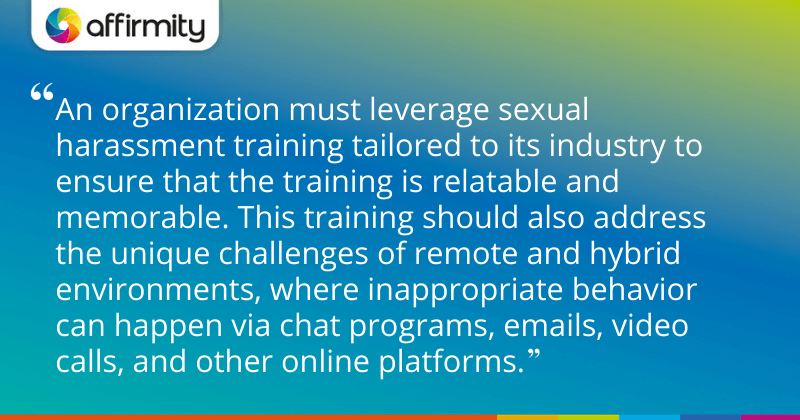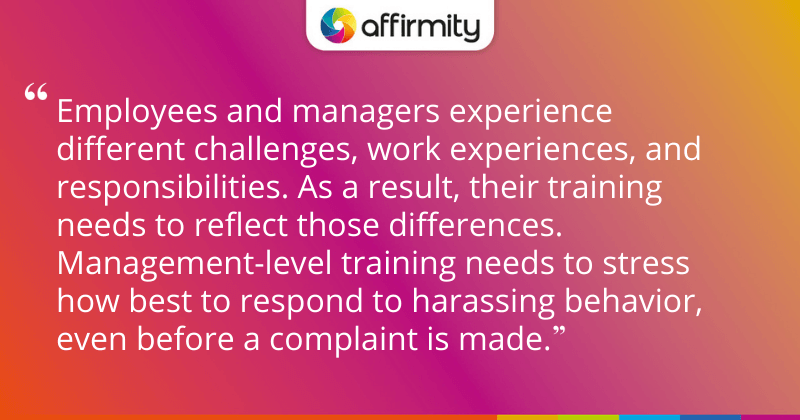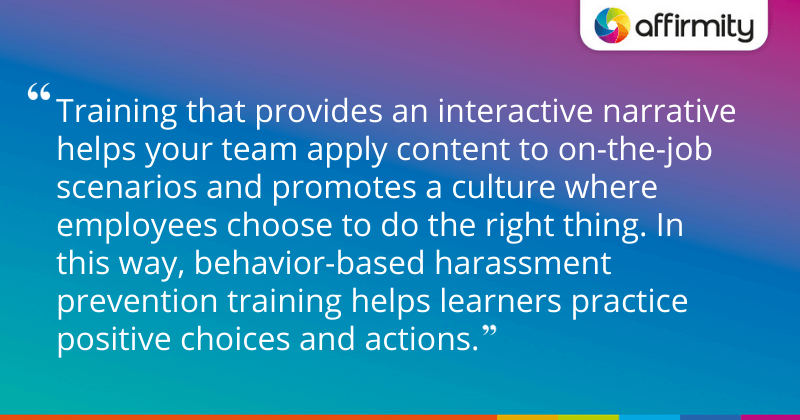As part of an effective sexual harassment prevention policy and program, the Equal Employment Opportunity Commission (EEOC) recommends a range of training tactics focused on maximizing relevance, retention, and overall value. In this article, Maggie Smith, a Senior VP of Human Resources for Affirmity training partner Traliant, looks at six critical characteristics of effective EEO training, as identified in EEOC guidance.
Recommendation #1: Choose Training Tailored to Your Industry
Across industries and working environments, sexual harassment remains a widespread issue. In its guidance, the EEOC says “harassment training may be most effective when it is tailored to the organization and audience.” It has also stated that “when developing training, the daily experiences and unique characteristics of the work, workforce, and workplace are important considerations.”
What this means for you: An organization must leverage sexual harassment training tailored to its industry to ensure that the training is relatable and memorable. This training should also address the unique challenges of remote and hybrid environments, where inappropriate behavior can happen via chat programs, emails, video calls, and other online platforms.
MORE FROM THE BLOG | ‘5 Self-Critical Questions That Help Organizations Support the Career Mobility of Marginalized Groups’

Recommendation #2: Cover the Preferred Languages of Your Learners
Every individual deserves equitable treatment at work, no matter what language they are most comfortable speaking. The EEOC gives this guidance for diverse employee populations: “Workplaces that are diverse pose a risk factor for harassment, as different cultural backgrounds may cause employees to be less aware of laws and workplace norms, which can affect both their behavior and their ability to recognize prohibited conduct.” And it goes on to say, “workers who do not speak English may not know their rights and may be more subject to exploitation.”
What this means for you: Providing translated anti-harassment policies and training ensures your entire team understands expected behaviors and knows how to report incidents.
Recommendation #3: Provide Employee and Manager Versions of the Training
Every version of your sexual harassment prevention training should cover what is considered illegal conduct, the reporting options available, and the consequences of inappropriate behavior. However, supervisory staff have the additional responsibilities of practicing “situational awareness” and responding to reports quickly, and their training must cover this information.
According to the EEOC, training that is specifically targeted at managers or supervisors should provide “easy-to-understand and realistic methods for dealing with harassment that they observe, that is reported to them, or of which they have knowledge or information, and clear instructions on how to report harassing behavior up the chain of command.”
What this means for you: Employees and managers experience different challenges, work experiences, and responsibilities. As a result, their training needs to reflect those differences. Management-level training needs to stress how best to respond to harassing behavior, even before a complaint is made.
MORE ADVICE ON TAILORING YOUR EFFORTS | “Getting the Business On Your Side: How to Talk About Affirmative Action Data With Everyone Else”

Recommendation #4: Provide Training That Supports a Speak-Up Culture
Three out of four employees who experience workplace harassment never report the incident to a supervisor, manager, or HR representative. Their reasons for remaining silent include fear they would not be believed, doubt that anything will be done, and suspicion they would be blamed or that they would face retaliation.
To remedy the issue, the EEOC notes that harassment prevention training should focus on behaviors that help build a speak-up culture and provide “employees with the specific skills they need to stop improper behavior before it ever rises to the level of illegal harassment.” The relevant areas of training are:
i) Avoiding Retaliation
Retaliation accounts for 51.6% of all claims to the EEOC, making it the most common offense reported. Any negative actions by managers or other employees after a harassment claim have the potential to be considered retaliation. If a misconduct claim is made in good faith, the EEOC deems retaliation illegal, regardless of whether a misconduct claim is proven to be true or not.
ii) Bystander Intervention
The EEOC calls bystander intervention training, “a game changer that can have a positive impact on workplace culture by creating a sense of collective responsibility.” Adding this training to your program ensures that you will teach techniques to safely confront and disrupt inappropriate behavior while empowering your workforce to support targets of harassment and report misconduct.
What this means for you: Taking a holistic approach to your sexual harassment prevention program by including training on retaliation and bystander intervention can help you create a culture of accountability.

Recommendation #5: Create Real Change With Behavior-Based Training
The end goal of any effective compliance training program is to change behavior. This means that focusing solely on what employees should not do may not have the desired effect. Accordingly, the EEOC recommends delivering harassment prevention training that is based on what employees can actively do to create a culture of respect.
Training that provides an interactive narrative helps your team apply content to on-the-job scenarios and promotes a culture where employees choose to do the right thing. In this way, behavior-based harassment prevention training helps learners practice positive choices and actions.
What this means for you: By providing behavior-based training, you’re enabling your team to see the outcome of their decisions and make good choices.
FURTHER TRAINING INSIGHTS | ‘5 Ways to Protect Your Organization From Self-Sabotaging DE&I Training’
Recommendation #6: Year-Round Awareness Doesn’t Mean Delivering The Same Training Year After Year
No one wants to take the same training again and again. In fact, it’s likely that forcing employees to endlessly repeat the same training will decrease engagement and knowledge retention. The EEOC cautions employers to avoid “simply repeating the same training over and over, which risks becoming a rote exercise.” Instead, it encourages employers “to consider training that is varied and dynamic in style, form, and content.”
Nonetheless, one of the key recommendations is making harassment prevention more than a once-a-year focus. The EEOC notes: “If anti-harassment training is held once a year (or once every other year), employees will not believe that preventing harassment is a high priority for the employer. Conversely, if anti-harassment trainings are regularly scheduled events in which key information is reinforced, that will send the message that the goal of the training is important.” Your training program should be continuous and updated regularly to remain relevant and compliant.
What this means for you: Your ongoing sexual harassment prevention program should include training that promotes a respectful workplace. And to keep your team engaged, your training should be refreshed regularly.
Prevent Sexual Harassment With Comprehensive Training
Affirmity has partnered with Traliant, the industry leader in compliance training, to provide online, interactive training on preventing discrimination and harassment to organizations like yours. The course is a behavior-based design that incorporates real-world video scenarios and interactive challenges to maximize engagement, learning, and retention.
To learn more about the training and sign up for a free trial, connect with our team today.
About the Author
Maggie Smith is Senior VP of Human Resources at Traliant. With over 20 years of experience, she has developed, implemented, and led HR programs for complex, multi-site organizations and is versed in translating business vision into HR initiatives that enhance performance, profitability, growth, and employee engagement.
